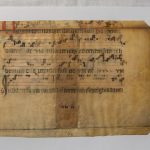The fragment draws attention with its proportionate, aesthetic chant notation, which reminds us the writing layout of a fragment (Qu 406-13) kept in the National Archives of the Hungarian National Archives. Both pieces certainly derives from the same mother codex (for more on this, see Fanni Hende, “Fragments in the pre-Mohács collection of the National Archives”, Turul 91/2, 2018, 73). In the musical script of the fragments, we can identify an early 15th-century musical script, which follows the purest medieval copying tradition of Esztergom, and which, despite the thickening of the pen strokes, adheres to the archaic writing direction, i.e. the verticality of the climacus and its point series in the neume combinations. This is the most defining feature of the musical script: the conciseness and strict consistency in keeping the direction of writing. In the early 15th century Hungarian music notations, this verticality was first lost (see, for example, the Transylvanian antiphoner fragments from Güssing). In the case of the fragment of the Pauline Library, however, it was not the direction of the writing that was changed first, but the conjunction of the neume elements: the disintegration of the sctructures became the main area of modernisation. Due to the dimensions of the codex (the staves are also extremely short), the notator did not have to compromise on the alignment of the puncta, the desired goal could be achieved without reducing the size of the note heads, so that the basic neume remained one size throughout, both alone and in neuma composition, despite the old vertical arrangement. A striking element on the fragment is that, in addition to the double-pointed beginning of the climacus (the conjunct climacus form is also present in the writing as an alternative), a single punctum is increasingly used as the initial note of this neume, especially in compounds, and this immediately closes the way to a possible Pauline orientation. (I.e. the Paulines in the 15th century still insisted on the double-headed climacus, even in neume combinations, and only from the 16th century onwards do we see some change in this.) In addition to the climacus form, the clear segmentation of the neume structures also argues against the Pauline origin; in fact, the notation is distinctly modern in its approach, if we consider that all the basic neumes and compositions, with the exception of the clivis and the conjunct climacus, are seen as separate units of separate elements joined together. At the end of the lines there is pipe-shaped custos, which tilts the dating towards the beginning of the 15th century, but the increasingly regular rhomboid punctum forms also point to this period. In addition to the direction of the writing, the scandicus has its roots in Esztergom tradition, and the forming of its middle note as a stroke gives a sense of the old ligation.
The exceptionally beautiful and well-ordered, traditionalistic Esztergom notation preserves parts from the Masses for the post-Pentecostal 5th and 6th Sundays (the source reveal liturgical chants from Holy Saturday and Easter: the Ordinary of the Mass and also the Proprium, including the trope Iam domnus optatas, the Alleluia, Vespers antiphons, an antiphon for Blessing of water at Easter). The fragment from the Pauline Library is less than half a folio (1 folio = 10 staves on the fragment from the National Archives, which is a full leaf, here only 4 lines are read), so we can reconstruct a smaller part of the content here. On the recto, the introit of the 5th Sunday after Pentecost (Vocem iucunditatis) is the first to appear (with the verse Iubilate Deo), but at the end of the line, next to the rubric Do[minica] V, we can also see the end of the communion of the 4th Sunday (Dum venerit Paraclitus): …alleluia. After a small omission on the verso, the introit of the 6th Sunday (Exaudivit de templo) begins, the incipit is missing, and the following Alleluia can be identified even in the absence of a verse, on the basis of the melody: Alleluia Confitemini Domino. The liturgical content of the fragment is closely linked to Esztergom. The melodies abound in pentatonic details, standing close to the versions of the Missale Notatum Strigoniense (http://cantus.sk/source/16685) and the Graduale Strigoniense „Bakócz” http://hun-chant.eu/chants-mass?source=1295), with a number of minor melodic variations.
If the melodic arguments were more supportive of the narrower Esztergom tradition, this is how we would imagine the Esztergom mixed notation of the late 14th and early 15th centuries, which evolved from calligraphic musical script into monumental Gothic codex notation, i.e. the unknown (so far undocumented by sources) transitional notation of the Esztergom cathedral. The melodies themselves, however, can not support this idea, so the place of origin of the codex must presumably be sought within the diocese of Esztergom, but somewhat far away from the cathedral.
Gabriella Gilányi



